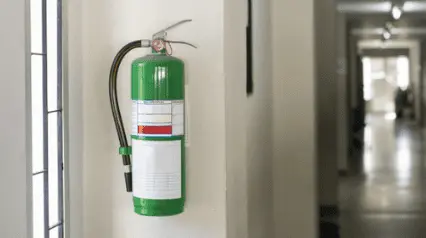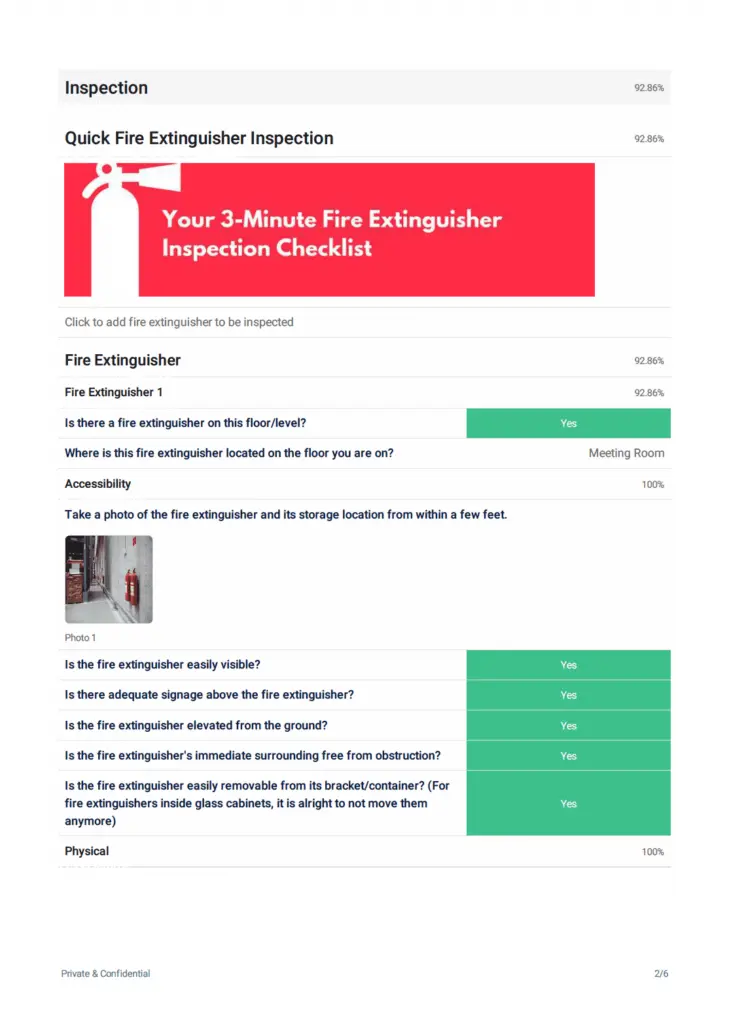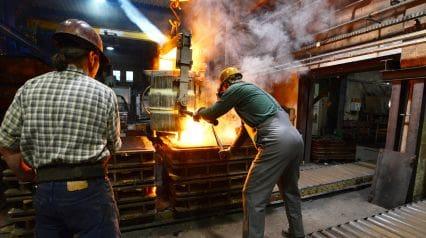What is a Fire Extinguisher Inspection?
A fire extinguisher inspection is conducted to check the condition and it includes both fire extinguisher maintenance and testing. An external safety professional or an organization’s own safety officer conducts a monthly fire extinguisher inspection as part of the overall fire safety strategy and it includes both fire extinguisher maintenance and testing.
Over 90% of fires in commercial properties are extinguished early on by members of the public using a fire extinguisher. Even a single malfunctioning fire extinguisher can put countless lives at risk. A safety officer’s job is to perform regular fire extinguisher inspections and maintain up-to-date records to keep buildings and tenants safe from any fire hazard. It is critical that a safety officer knows how to efficiently perform a fire extinguisher inspection, is aware of the most common issues identified during an inspection, and knows how to respond accordingly.
Importance of Inspection Tags
Labeling of fire extinguishers is a requirement in accordance with OSHA’s Hazard Communication under Toxic and Hazardous Substance standards, specifically 1910.1200(f)(5) and 1910.1200(f)(6). These regulations are aimed at the chemical manufacturers and employers where the fire extinguishers are located. While recordkeeping of fire extinguisher inspections using a tag, label, paper or electronic files is a standard set by the National Fire Protection Association. NFPA also recommends having a separate fire extinguisher inspection log.
On top of complying with the standards and other safety tips, this will ensure that fire extinguisher inspections are consistently conducted by the employees. Additionally, having records of these inspections will come in handy in the event an external inspector will check the compliance of the workplace in regard to fire extinguishers.
Is Fire Extinguisher Inspection a Requirement by OSHA?
Yes, fire extinguisher inspection is a requirement. According to the Fire Protection for portable fire extinguishers standards of OSHA, The employer is responsible for inspection, maintenance, and testing (ITM) of all available portable fire extinguishers in the workplace (1910.157(e)(1)).
Monthly visual inspections of these fire extinguishers are expected (1910.157(e)(2). The portable fire extinguishers standard also requires an annual maintenance check with the date recorded. The employer is responsible for ensuring that these extinguishers are maintained a year after the last entry.
Carbon dioxide extinguishers are required to be tested every 5 years at 5/3 of the service pressure stamped onto the cylinder while nitrogen extinguishers are hydrostatically tested every 10 years.
Improve your EHS Management
Cultivate a safe working environment and streamline compliance with our EHS solutions.
Explore nowHow Often Do Fire Extinguishers Need to be Examined?
As a fire prevention effort, fire extinguishers need to be checked during initial installation and every month thereafter as required by the National Fire Protection Association (NFPA). The frequency of the fire extinguisher inspection can be adjusted according to its environment.
For example, more frequent inspections should be conducted if the area that it was stored in is prone to tampering, rust, and other elements that could damage the extinguisher.
NFPA states that these monthly fire extinguisher inspections should be recorded for at least 12 months. Information such as the month and year of the inspection and the person who conducted it should be recorded on a label or electronic file.
How to Perform a Fire Extinguisher Inspection in 3 Minutes
A lot of things are to be considered when it comes to ensuring that fire extinguishers are in their ideal spots and can be used as effectively as necessary during emergencies. First, since different types of extinguishers are used to respond to different fire types, position them based on the fire class that is possible to occur in the area—may they be ordinary fires, electrical fires, or grease fires, among others.
And then when performing a monthly fire extinguisher inspection, it is important to follow these 5 key steps.
- Check accessibility.
- Examine the physical state
- Check the pressure gauge
- Notice the inspection tag
- Generate report and recommend action plan/s
Once you have learned what to look out for, you should expect to safely complete your inspection in 3 minutes. Here’s the complete guide on how to inspect a fire extinguisher:
1. Check accessibility – Check its visibility and accessibility:
- Identify if a fire extinguisher is present in the area and take note if it is easily visible, especially in highly flammable zones.
- It should not be blocked by any equipment or other objects that would make it difficult to access during an emergency.
- Portable fire extinguishers other than wheeled types must also be secured in a specific location (e.g. inside an unlocked glass cabinet or a wooden box) to prevent them from being moved.
2. Examine the physical state – Next, pick up the fire extinguisher to closely check for labeling, overall condition, and physical defects:
- Look for the fire extinguisher’s serial number, and check if the fire extinguisher label is readable.
- Check if the cylinder and other external metal parts are free of corrosion, dents, and other signs of damage.
- Check the connection between the hose and cylinder is secure.
- Inspect if there are cracks in the hose or leak in the nozzle.
- Check if the locking pin goes through the holes of the discharge lever and handle and if the pin is secured well by the seal. The pin locks the discharge lever and prevents it from accidentally being discharged.
3. Check the pressure gauge – Examine where the gauge needle is. A needle within the green zone is good. A needle in the left red zone means that the fire extinguisher is undercharged and warrants a recharge, while a needle in the right red zone signals a danger of being overcharged.
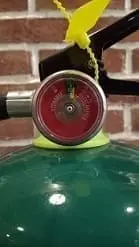
Pressure Gauge
4. Look for the inspection tag – Note if an inspection tag is available. The tag should indicate that a fire extinguisher is regularly inspected.
5. Generate report and recommend action plan/s – After the inspection, summarize observations/ action plan. Make sure to sign off on the fire extinguisher inspection tag (if available) with your name/signature and date of inspection. That’s it!
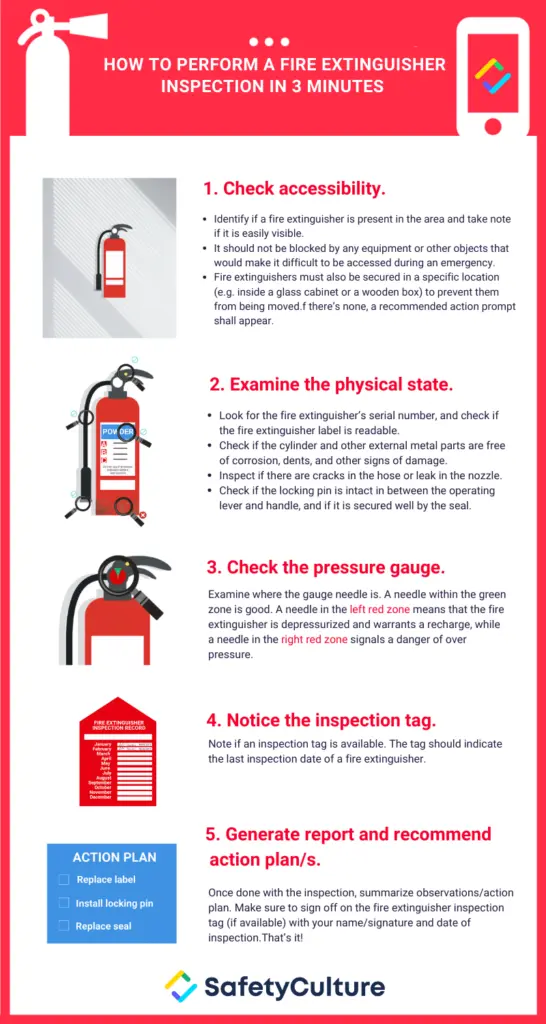
Fire Extinguisher Inspection Guide
Feel free to save this fire extinguisher inspection guide to help the people in your organization remember the steps more easily.
Create Your Own Fire Extinguisher Inspection Checklist
Eliminate manual tasks and streamline your operations.
Get started for FREETop 5 Most Common Issues Identified During a Fire Extinguisher Inspection and What to Do
While it is important to know how to identify a proper-functioning fire extinguisher, it is equally important to be aware of the common issues that arise and how to respond:
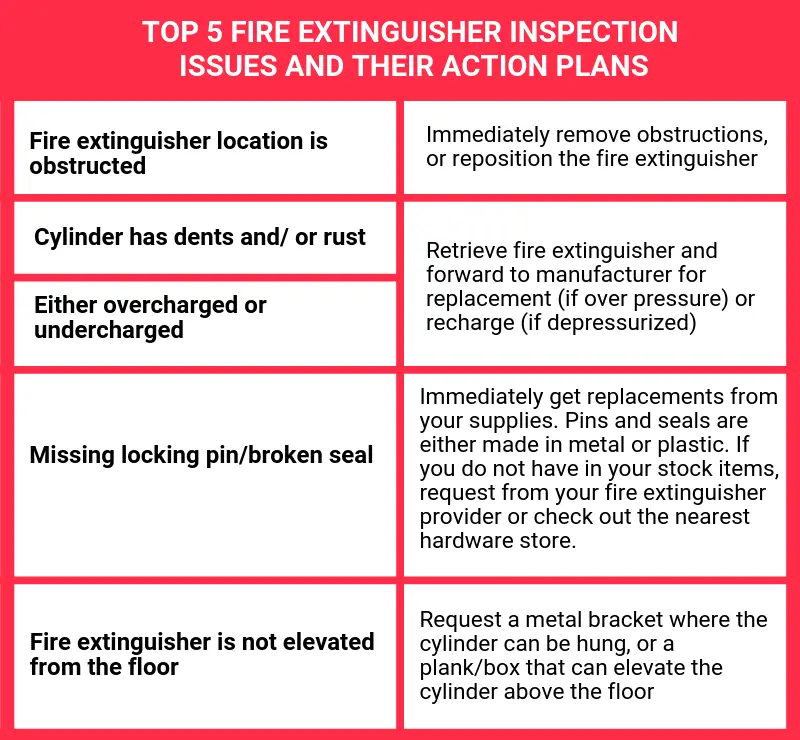
Most Common Issues in a Fire Extinguisher Inspection
Fire extinguisher location obstructed
Issue: When a fire extinguisher is obstructed, it could mean the difference between life and death. Pay attention to instances where a portable fire extinguisher may be behind furniture, office equipment, and doors, or hidden under office desks and sink cabinets.
Action: You should immediately remove obstructions, or reposition the fire extinguisher. Make sure it is easily seen by everyone. Place it along a natural path of travel, such as a hallway or an entrance/exit. Post it under a clear fire extinguisher signage.
Cylinder has dents and/or rust
Issue: As fire extinguishers often remain unused, they can experience physical deterioration due to humid or corrosive environment, constant transfers, or accidental bumps. Physical defects can lead to malfunction or dangerous explosions.
Action: Immediately forward the cylinder to the manufacturer for replacement.
Fire extinguisher overcharged or undercharged
Issue: An extinguisher with a good charge will have sufficient velocity to spur the chemical 10-20 feet. An overcharged fire extinguisher can cause leakage or worse, a cylinder explosion. An undercharged one can be equally dangerous and be unable to extinguish fire.
Action: Immediately forward the cylinder to the manufacturer for replacement /recharge.
Locking pin missing/broken seal
Issue: Locking pins and seals can go missing when they have not been replaced after training exercises, have been tampered, or were simply not installed in the first place. These two must always go together as they prevent accidental pressing of the lever and release of the fire extinguisher’s contents.
Action: Whichever is missing, immediately get replacements from your supplies. Pins and seals are either made of metal or plastic. If not in stock, contact your fire extinguisher provider or go to your nearest hardware store.
Fire extinguisher not elevated from the floor
Issue: A fire extinguisher directly on the floor may cause others to accidentally bump it off, which can further cause dents to the body. The changing temperature of the floor can also directly affect the fire extinguisher, which can cause change in pressure.
Action: Depending on the cylinder size, the standard practice is to mount it via metal brackets on a wall, 3.5 – 5 feet above the floor. Alternatively, you could also use wooden or steel fire extinguisher stands.
This sample fire extinguisher inspection report presents the findings, evidence, and recommended action plans:
